나노물질








나노유체에 대한 연구는 에너지 시스템 응용(예:태양열 집열기, 냉동, 히트 파이프 및 에너지 저장)을 위한 열 또는 대량 수송, 유동성 및 분산 안정성에서의 매혹적인 특성으로 인해 폭발적으로 증가하고 있습니다. 검토의 두 번째 부분은 TiO2 적용에 대한 최근 연구를 요약합니다. 나노유체 및 TiO2의 추가 탐사를 위한 도전과 기회를 식별합니다. 나노유체. 두 개의 철저한 검토가 연구자들이 TiO2의 연구 현황에 대한 지식을 업데이트하는 데 유용한 참고 가이드가 될 것으로 기대됩니다. 나노유체, 비판적 논평, 도전 과제 및 권장 사항은 향후 연구 방향에 유용할 수 있습니다.
<섹션 데이터-제목=" 검토 ">첫 번째 부분에서는 제조, 안정성 및 특성에 대한 연구를 검토했습니다. 나노유체의 제조 방향과 특성에 대해 많은 연구가 진행되고 있음을 알 수 있다[1,2,3,4,5,6,7]. 한편, 특히 에너지 시스템에서 나노유체의 응용을 위한 많은 시도가 이루어지고 있다[8,9,10,11]. 열 및 물질 전달 과정의 향상으로 인해 TiO2 나노유체는 태양열 집열기[12], 냉각[13,14,16], 에너지 저장[17, 18], 히트 파이프[19,20,21] 및 기타 에너지 응용[22,23] 분야에 잠정적으로 적용되었습니다. ,24,25,26,27,28,29,30,31,32,33,34] 자동차 라디에이터[31], PV/T 하이브리드 시스템[32, 33], 열병합 발전(CHP ) 시스템 [34]. 우리의 이전 연구에서 TiO2의 열전달 특성은 나노유체의 열전도, 강제 대류 비등 열전달, 자연 대류 열전달을 요약하였다[35]. 그러나 TiO2의 적용에 대한 포괄적인 요약과는 거리가 멀다. 나노유체; TiO2에 대한 실용적인 응용 프로그램도 많이 있습니다. 나노유체. 여기 2부에서 TiO2의 열전도도 및 에너지 관련 응용 분야에 대한 자세한 검토를 제공합니다. 나노유체. 이전 보고서[35]와 결합된 두 가지 검토가 TiO2의 연구 진행 상황에 대한 포괄적인 이해를 제공할 수 있기를 바랍니다. 나노유체. 나노유체 기술의 발전으로 나노유체는 이러한 에너지 시스템을 위한 새롭고 효율적인 작동유체로 실용화될 것으로 기대된다.
나노유체의 뛰어난 성능은 일반적으로 나노입자가 첨가된 유체의 물리적 특성에 기인하므로 나노유체의 열전도도에 대한 실험적 또는 이론적 연구는 나노유체 분야에서 중요한 화두가 되어야 한다. 대부분의 리뷰 기사에서는 물성 부분에서 열전도율을 도입했지만, 열전도율을 높이는 것도 나노유체의 중요한 응용 측면입니다. 응용 부분에 열전도율을 넣는 또 다른 이유는 두 리뷰의 내용의 균형을 맞추기 위해서입니다.
많은 실험 및 이론 연구 결과에 따르면 나노 입자를 추가하면 유체의 열전도도를 뚜렷하게 향상시킬 수 있습니다. 나노유체의 열전도율에 대한 영향 요인은 다음과 같은 그룹으로 유도될 수 있습니다. 및 기본 유체의 유형[41] 및 가능한 계면활성제 또는 pH 조절기[42, 43](있는 경우); (2) 온도[40], 초음속 진동 시간[44], 저장 시간[45] 또는 실행 시간[46]을 포함한 외부 요인; 및 (3) 나노 입자의 표면 전하 상태[47], 입자 클러스터[48], 계면 나노층[49], 브라운 운동[50], 응집[51], 계면 열 저항 및 질량과 같은 미시적 요인[47] 차이 산란 [52]. 우리의 이전 연구는 TiO2의 열전도율을 보여주는 표를 제공했습니다. 나노유체[35]. 그러나 영향도에 대한 서로 다른 영향요인을 이해하는 것은 직관적이고 불편하지 않다. 따라서 이 2부에서는 TiO2의 열전도율에 대한 영향 나노 유체는 더 지각적인 이해를 제공하기 위해 그림으로 표시됩니다.
TiO2의 열전도율 증가량 요약 – 이용 가능한 문헌에서 나노 입자의 부피 분율을 갖는 물 나노 유체는 그림 1에 나와 있습니다. 모든 실험 결과에서 TiO2 나노 입자는 기본 유체의 열전도율을 향상시킬 수 있습니다. 그러나 서로 다른 연구의 증가분은 근본적으로 다릅니다. 예를 들어, 나노유체의 열전도도 향상은 TiO2 부피 부하의 약 2-4배입니다. Masuda 등을 포함한 나노 입자. [53], Turgut et al. [54], Zhang et al. [55], Wang et al. [56], Pak and Cho [57], Yang et al. [58], 그리고 Mused et al.의 [59] 결과. 다른 향상은 TiO2의 볼륨 로딩의 6-20배에 달할 수 있습니다. Yoo et al. [60], Wen and Ding [61], Mushed et al. [62], He et al. [63], Chen et al. [64] 및 Saleh et al.의 [65] 결과.
<그림>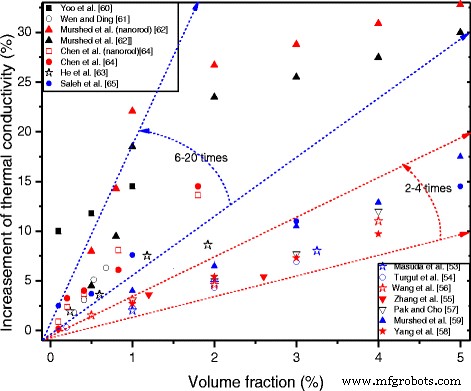
TiO2의 열전도율의 부피 분율 의존성 – 이용 가능한 문헌의 물 나노유체
결과의 차이는 아마도 부피 분율 외에 TiO2의 열전도율의 결과일 것입니다. 나노유체는 또한 입자의 매개변수와 입자 크기 및 모양, 계면활성제, pH 값, 온도와 같은 환경적 환경에 의해 결정되는데, 이는 서로 다른 작업에서 상당히 달랐습니다. 또한 일부 연구자들은 나노입자가 TiO2의 열전도율에 거의 영향을 미치지 않는다는 것을 관찰했습니다. 나노유체. Utomo et al. [66] 수성 알루미나와 티타니아 나노유체의 열전도율을 조사하였다. 그들은 TiO2의 열전도율이 그들이 준비한 나노유체는 분산제의 높은 함량으로 인해 기존 모델 예측보다 약간 낮았습니다. 그리고 그 결과는 TiO2 나노 유체는 다른 보고서에서 볼 수 있듯이 파이프 흐름에서 비정상적인 열전도도 향상 또는 대류 열전달 계수를 나타내지 않습니다.
나노 입자의 모양과 크기의 영향은 입자 로딩의 영향만큼 광범위하게 조사되지 않았습니다. 기존 연구에서는 TiO2의 열전도율에 대한 입자 모양이나 크기에 큰 영향을 보이지 않았습니다. 이것은 아마도 이 효과에 대한 상대적으로 적은 양 때문일 것입니다. Murshed et al. [62] 두 종류의 TiO2 분산 CTAB를 분산제로 사용하는 나노 입자 물. 한 종류는 지름이 10nm × 40nm인 막대 모양입니다. 그리고 다른 유형은 직경이 15nm인 구형입니다. 그들은 두 종류의 TiO2의 열전도율을 관찰했습니다. 나노유체는 입자 로딩이 증가함에 따라 증가하는 반면 막대형 입자는 구형 입자보다 더 많은 기여를 하였다. 전자와 후자의 열전도율의 최대 향상은 각각 약 33%와 30%였습니다. Chen et al. [64]는 TiO2로 직교하는 4가지 유형의 나노유체에 대한 유효 열전도율을 연구했습니다. 나노입자(25nm) 및 TiO2 나노튜브(10nm × 100nm)를 기본 유체로 각각 물과 EG를 사용합니다. 그들은 TiO2의 향상 사이의 차이점을 발견했습니다. 나노입자 및 TiO2 열전도율에 대한 나노튜브는 크지 않은 반면 향상은 Hamilton-Crosser 방정식의 계산 값보다 훨씬 큽니다.
온도는 TiO2의 열전도율에 대한 또 다른 중요한 영향 요인입니다. 나노유체. 그림 2는 TiO2의 열전도도 향상에 대한 온도의 영향을 보여줍니다. 다양한 연구에서 나노 유체. Wang et al. [67]은 수성 TiO2의 열전도율에 대한 입자 로딩 및 온도의 영향을 조사했습니다. 나노유체. 결과는 작동 온도가 더 중요한 긍정적인 역할을 하고 더 높은 온도에서 열전도율에 더 많은 기여를 한다는 것을 보여주었습니다. 그들은 또한 온도 의존적 브라운 운동과 미소 대류를 고려하여 결정된 이론적인 값과 결과가 일치한다고 결론지었습니다. Reddy et al. [68] TiO2의 열전도율을 조사했습니다. 다양한 온도에서 0.2~1.0% 범위의 다양한 입자 로딩을 위한 나노유체. 그리고 그들은 TiO2의 열전도율을 관찰했습니다. 나노유체는 입자 로딩과 온도가 모두 증가함에 따라 증가합니다. Yang et al. [58] TiO2 추가 이원 유체 기반 나노 유체를 제조하기 위해 나노 입자를 암모니아-물로 변환합니다. 그들은 또한 온도의 증가가 이원 TiO2의 열전도율을 증가시킬 수 있음을 발견했습니다. 나노 유체를 기본 유체로.
<그림>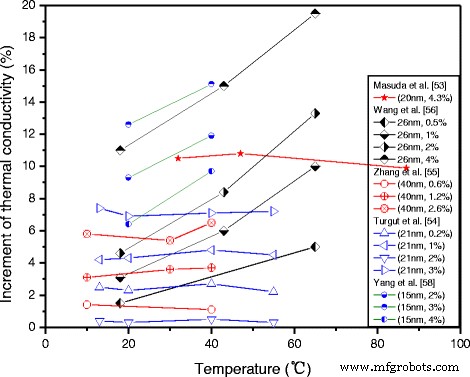
TiO2의 열전도도 향상에 대한 온도의 영향 다양한 연구의 나노유체
위의 결과는 TiO2 나노 입자는 TiO2의 열전도율에 더 많은 기여를 할 수 있습니다. 더 높은 온도에서 나노 유체. 그러나 온도의 영향에 대한 일부 단일 결과도 포함될 수 있습니다. Turgut et al. [54] 탈이온수 기반 TiO2의 유효 열전도율을 조사했습니다. 13, 23, 40, 55°C의 온도에서 나노유체 그들은 입자 부하가 증가함에 따라 열전도율이 증가하지만 온도 변화는 TiO2의 유효 열전도율에 거의 영향을 미치지 않는다는 것을 관찰했습니다. 나노유체. 또한 일부 결과에서는 온도가 유효 열전도율에 역할을 하는 것으로 나타났습니다. Duangthongsuk 및 Wongwises [69] 정지 TiO2 부피 로딩 범위가 0.2~2%인 물에 나노 입자를 넣고 15~35°C의 온도 범위에서 데이터를 수집했습니다. 그들은 측정된 TiO2의 열전도도를 관찰했습니다. – 물 나노유체는 입자 부하와 온도가 모두 증가함에 따라 증가했지만 온도가 증가하면 열전도율은 감소했습니다. 그들은 그 이유를 기본 유체의 열전도율이 더 빠른 속도로 증가시켰기 때문이라고 설명했습니다.
TiO2의 열전도율에 대한 온도의 불확실한 역할의 이유 나노유체는 나노유체의 열전도도의 복잡한 메커니즘 때문일 수 있습니다. 온도가 변하면 구조, 표면 활성, 입자의 안정성, 분산제의 특성 등과 같은 다른 매개변수가 변경될 수 있으며 이러한 매개변수는 일반적으로 작업마다 많이 다릅니다. 따라서 TiO2의 열전도율에 대한 온도의 영향 나노 유체는 특정 나노 입자 및 기본 유체 유형과 관련이 있습니다. 이러한 관찰은 온도 의존적 열전도도 거동이 아나타제 및 금홍석 TiO2에 대해 연구된 Cabaleiro et al.의 연구[41]에 의해 더욱 향상될 수 있습니다. 에틸렌과 프로필렌 글리콜을 기본 유체로 하는 나노유체. 이 4가지 종류의 TiO2의 열전도율의 온도 의존성 나노유체를 Fig. 3에 나타내었다. 4가지 종류의 나노유체 모두 해당 기본유체보다 높은 열전도도를 나타냄을 알 수 있다. 온도는 TiO2에 대해 다른 역할을 했습니다. 서로 다른 나노결정 구조의 나노입자와 서로 다른 기본 유체를 포함하는 나노유체. EG 기반 나노유체의 경우 온도가 증가함에 따라 열전도율이 증가하여 연구 범위의 온도에 따라 최대 11.4% 증가하는 반면 PG 기반 나노유체의 경우 온도와 거의 무관한 것으로 나타났습니다.
<그림>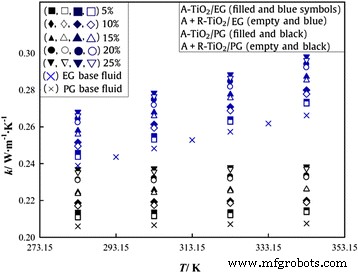
4종의 TiO2 열전도율의 온도 의존성 나노유체[41]. Elsevier의 허가를 받아 복제됨
기본 유체의 성분은 TiO2의 열전도율에도 영향을 줄 수 있습니다. 나노유체. Chen et al. [64]는 구형 및 관형 TiO2의 유효 열전도율을 측정했습니다. 물과 에틸렌 글리콜을 기본 유체로 하는 나노 유체. 그들은 TiO2 나노입자 및 TiO2 기본 유체로 EG를 갖는 나노튜브는 기본 유체로서 물을 갖는 나노튜브보다 더 높았다. Reddy et al. [68]은 수성, EG/W(40%:60%) 기반 및 EG/W(50%:50%) 기반 TiO2에 대한 열전도도 향상을 발견했습니다. 나노유체는 TiO2의 부피 농도가 0.649에서 5.01%로, 1.94에서 4.38%, 10.64에서 14.2%로 각각 증가했습니다. 나노 입자는 실온(30°C)에서 0.2%에서 1.0%로 증가했습니다. 그러나 일부 반대 결과도 관찰될 수 있습니다. Cabaleiro et al. [41]은 TiO2에 대한 열전도도 향상을 발견했습니다. EG, PG 또는 파라핀 오일을 기본 유체로 하는 나노 유체는 기본 유체로 물을 사용하는 나노 유체보다 현저히 낮습니다. 또한 Sonawane et al.의 보고서[70]에서 기본 유체의 효과는 TiO2의 열전도율 때문에 복잡하고 접근할 수 없는 것으로 생각되었습니다. 1 vol.% 입자 로딩을 갖는 나노유체는 파라핀 오일 기반 나노유체> 수성 나노유체> EG 기반 나노유체의 순서를 따랐지만 순수한 기본 유체는 물> EG> 파라핀 오일의 순서를 따랐습니다. 그들은 점성 효과의 관점에서 이러한 불규칙한 관찰을 분석하고 낮은 기본 유체 점도가 나노 유체의 열전도도 향상에 더 많은 기여를 할 수 있다고 생각했습니다.
계면 활성제의 첨가는 TiO2의 열전도율에 대한 또 다른 중요한 요소입니다. 나노유체. 일부 결과는 계면활성제가 열전도율에 긍정적인 영향을 미치는 것으로 나타났습니다. Saleh 등[65]은 다양한 유형의 계면활성제가 TiO2의 열전도율에 미치는 영향을 연구했습니다. – 물 나노유체, 그 결과를 Fig. 4에 나타내었다. 세 종류의 계면활성제 모두 나노유체의 열전도도를 크게 향상시킬 수 있었고, 안정제로 SDS를 사용한 나노유체는 가장 큰 향상을 보였으며, 다음으로 CTAB 및 Span-80을 안정제로 사용합니다. 그리고 그들은 입자의 분산 안정성과 표면 특성이 나노유체의 열전도 향상에 관여한다고 생각했습니다.
<그림>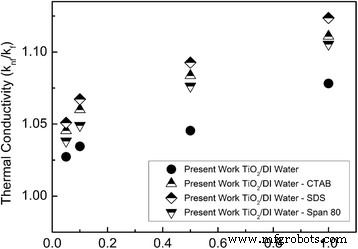
TiO2의 열전도율에 대한 다양한 계면활성제의 영향 – 물 나노 유체 [65]. Elsevier의 허가를 받아 복제됨
계면 활성제 효과에 대한 몇 가지 다른 결과도 있습니다. Yang et al. [58]은 기본 유체의 암모니아 함량이 증가할 때 TiO2의 열전도율이 증가함을 발견했습니다. TiO2의 안정성 때문에 나노유체도 증가합니다. 암모니아-물 나노유체는 더 높은 pH 값에서 개선될 것입니다. 그리고 저농도의 계면 활성제 PEG1000 및 PAA는 입자 또는 암모니아 함량, 온도와 같은 열전도율에 다른 영향 요인보다 상대적으로 작은 영향을 미칩니다. 그러나 PEG1000은 안정성을 향상시킬 수 있습니다. TiO2 나노유체의 열전도도 향상을 유도하는 암모니아-물 나노유체. Murshed et al. [62] 올레산과 CTAB가 TiO2의 분산 안정성을 향상시킬 수 있음을 발견했습니다. 실험에 사용된 계면활성제 함량이 매우 낮기 때문에 나노유체의 열적 물성 및 단상 열전달 계수에 영향을 미치지 않는 나노유체. 0.01–0.02 부피%. 계면 활성제가 우울 효과가 있음을 보여주는 일부 결과도 있습니다. Utomo et al. [66] 수성 Al2의 열전도율을 조사했습니다. O3 및 TiO2 나노유체. 그들은 안정제의 높은 부하가 두 종류의 나노유체의 효과적인 열전도율을 감소시킬 수 있음을 발견했습니다.
초음파 처리는 또한 TiO2의 열전도율에 약간의 영향을 미쳤습니다. 나노유체. Ismay et al. [71]은 TiO2의 열전도율이 – 물 나노 유체는 pH 값이 7에 가까울 때 최대값을 달성했으며 2시간 초음파 처리로 더욱 개선되었습니다. 그리고 그들은 응집이 침투 효과로 인해 관찰된 향상을 설명할 수 있다고 생각했습니다. Sonawaneet al. [70]은 초음파 시간이 열전도율에 미치는 영향에 대해 특별한 연구를 수행했으며 그 결과를 그림 5a-c에 나타내었다. 다양한 농도의 세 종류의 나노유체 모두에서 열전도율의 증가 비율이 먼저 증가하고 초음파 시간이 증가함에 따라 감소하는 것을 알 수 있으며 초음파 처리 시간 60분에서 최대 증가가 발생했습니다. 그들은 그 이유를 다음과 같이 설명했습니다. 최적의 초음파 처리 시간 60분은 나노 입자의 브라운 운동과 입자와 벌크 액체 간의 분자간 상호 작용을 강화하여 열전도율을 향상시킬 수 있습니다. 그러나 60분을 초과하는 장시간 초음파 처리는 나노입자의 클러스터링 및 응집을 유발할 수 있으며, 이는 나노입자의 열전달 및 열전도도 감소의 원인이 되는 것으로 생각되었습니다.
<그림>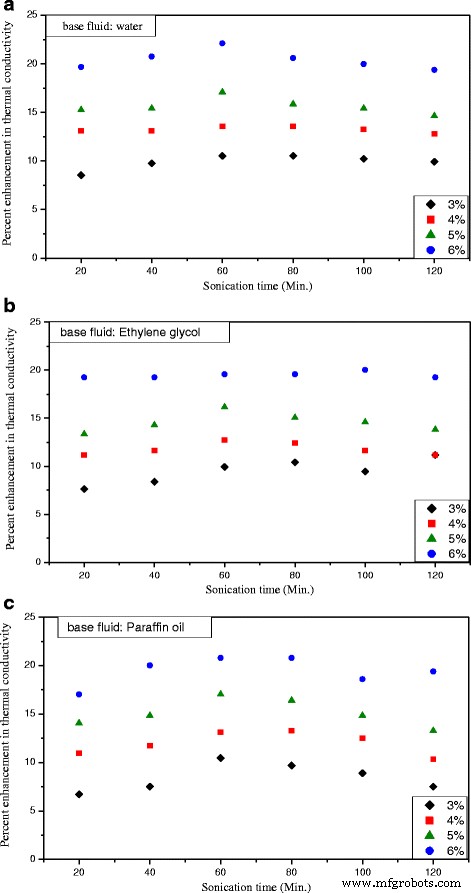
초음파 처리 시간에 따른 열전도율 향상 비율. 아 기본 유체:물. ㄴ 기본 유체:에틸렌 글리콜. ㄷ 기본 유체:파라핀 오일. 참고 문헌 [70]의 실험 데이터를 기반으로 다시 그렸습니다.
나노유체에 대한 이론적인 연구는 나노유체 분야의 연구 핫스팟 중 하나이다. 최근 몇 년 동안 수많은 열전도율 모델이 제안되었습니다. 일반적으로 TiO2에는 대부분의 기존 모델을 사용할 수 있다고 간주됩니다. 특별한 제한이 없는 한 나노유체. 그러나 TiO2의 열전도율 실험 데이터의 큰 차이로 인해 나노 유체의 경우 단일 모델이 모든 다른 결과에 적합하는 것은 거의 불가능합니다. 기존 모델은 개별 케이스에 적용하기 어렵기 때문에 일부 타겟 열전도율 모델은 TiO2 최근에는 나노유체도 제안되고 있다. 표 1은 TiO2에 특화된 사용 가능한 열전도도 모델 방정식의 요약을 제공합니다. 나노유체. 일부 모델에서는 계면층[59, 72], 브라운 운동[73, 74], 입자 크기 및 종횡비[72, 75], 응집[76]과 같은 요인이 고려되었음을 알 수 있습니다. 그리고 실험적 피팅이나 분산 분석만으로 제안되는 모델도 있다[68, 74, 77, 78, 79, 80, 81, 82]. 이러한 모델은 개별 사례에만 적합하다는 결론을 내릴 수 있습니다. 나노유체의 열전도율에 대한 이론적인 연구는 많이 발전되어 왔지만 가장 근본적인 결점은 서로 다른 실험 결과의 큰 차이에 있다. 나노유체의 열전도 과정은 나노구조와 입자의 미세운동을 정량적으로 설명하기 어렵기 때문에 이를 종합적이고 정확하게 파악하는 것은 다소 어렵다. 따라서 개별 응용 사례에 대한 모델의 정확도가 낮기 때문에 응용 시스템을 설계하기 위한 나노 유체의 열전도도를 얻는 가장 좋은 방법은 예비 실험을 수행하는 것입니다.
위의 분석은 현재 TiO2의 열전도율에 대한 영향 요인에 대한 논란과 불일치가 있음을 보여줍니다. 나노유체. 입자 로딩은 나노유체의 열전도도와 양의 상관관계를 나타내었지만 입자 모양, 크기, 기본 유체 유형, 온도, 계면활성제 및 초음파 처리를 포함한 다른 요인의 영향은 통일되어 있습니다. 입자 로딩 효과의 경우에도 열전도율의 성장 강도는 샘플마다 크게 다릅니다. 다양한 연구에서 나노유체의 열전도율이 일치하지 않는 것은 주로 열전도율이 여러 요인, 특히 정량적 분석이나 측정에 다소 어려운 입자 클러스터링 및 미세 운동과 같은 일부 미시적 매개변수에 의해 동시에 영향을 받기 때문입니다.
또 다른 논란은 나노유체의 열전도 향상 메커니즘이다. 입자 클러스터링 및 수집은 나노유체의 열전도 향상에 기여하는 것으로 생각됩니다[48, 50, 51]. 그러나 적절한 계면 활성제 또는 초음파 처리에 의해 응집이 적은 안정한 나노유체 역시 더 높은 열전도율을 보였다[62, 65, 66, 70, 71]. 나노유체의 열전도를 향상시키는 주요 메커니즘은 입자 클러스터링 또는 마이크로모션이거나 일부 다른 요인에 대한 추가 분석이 필요합니다.
재생 가능한 에너지의 깨끗한 원천인 태양 에너지는 환경에 미치는 영향이 최소화됩니다. 그러나, 태양열 집열기의 개발은 기존 작동 유체의 열악한 흡수 특성으로 인해 제한되었습니다. 따라서 최근 몇 년 동안 나노유체 기술은 우수한 열 및 광학 특성을 생성하기 위해 태양열 집열기에 점진적으로 사용되었습니다. 이 차세대 열전달 및 태양열 흡수 유체는 태양 에너지 사용 효율을 향상시킬 수 있을 것으로 기대됩니다.
그림 6과 같이 나노유체 기반 집광형 태양열 온수기의 전형적인 개략도는 Khullar et al.의 보고서[83]에서 볼 수 있다. 그들은 나노유체 기반 집광형 태양열 집열기를 구현할 때 상당한 양의 방출 감소와 에너지 절약을 달성할 수 있다고 생각했습니다. Chajiet al. [84] TiO2를 사용하는 소규모 평판 집전체의 효율에 대한 입자 함량과 액체의 유속 효과를 조사했습니다. 나노유체. 그들은 TiO2를 사용하여 수집기 효율성 지수를 찾았습니다. 유럽 표준 EN12975-2에 따라 나노 유체는 기본 유체에 비해 2.6~7% 증가했습니다. Said et al. [85] TiO2 사용 –H2 O 나노 유체는 평판 태양열 집열기의 성능을 향상시키기 위한 작동 유체입니다. 그들은 준비된 나노유체가 1개월 이상 안정적으로 유지될 수 있음을 관찰했습니다. 결과는 수성 기반 유체와 비교하여 에너지 효율이 76.6vol.% loading 및 0.5kg/min 유속으로 증가할 수 있으며 이러한 작동 조건에서 16.9%의 가장 높은 엑서지 효율을 달성할 수 있음을 보여주었습니다.
<그림>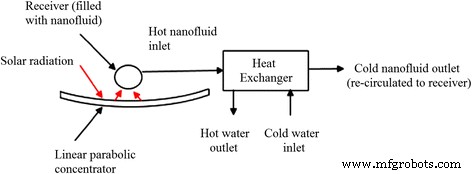
나노유체 기반 집광 태양열 온수 시스템의 개략도. 참조를 기반으로 다시 그려짐 [83]
최근에는 나노유체를 이용한 태양열 집열기의 성능에 대한 이론적인 연구도 진행되고 있다. Alim et al. [86] 엔트로피 발생, 열전달 특성 및 Al2의 압력 강하를 이론적으로 연구 O3 , CuO, SiO2 및 TiO2 층류에서 평판 태양열 집열기의 나노 유체. 그들은 마찰 계수가 수성 유체의 마찰 계수와 거의 유사하지만 모든 종류의 나노 유체가 성능을 향상시킬 수 있음을 발견했습니다. Faizal et al. [87] 또한 태양열 집열기에서 이러한 4가지 종류의 나노유체 성능에 대한 수치 연구를 수행했습니다. 그들은 4가지 종류의 나노유체 모두의 에너지 절약이 20%를 초과할 수 있으며, 이는 온실 가스 배출 감소로 이어질 수 있음을 관찰했습니다.
태양열 집열기에서 나노유체에 의한 성능 향상은 일반적으로 향상된 열 전달 특성과 광학 특성의 두 가지 주요 요인에 기인합니다. 따라서 태양광 흡수 시스템에서 나노유체의 광학적 특성도 연구자들이 조사하였다. Said et al. [88] TiO2의 태양광 흡수 성능에 대한 실험 및 분석 연구를 모두 수행했습니다. 및 Al2 O3 나노유체. 그들은 감광성 특성 조사를 위해 0.1에서 0.3 vol.%의 두 가지 부피 분율을 사용했습니다. Rayleigh, Maxwell-Garnett 및 Lambert-Beer의 접근 방식을 포함한 일부 고전 이론이 분석 분석에 채택되었습니다. 그들은 TiO2의 광학적 특성이 나노유체는 Al2보다 높았다. O3 모든 입자 로딩에 대해 가시광선 범위 내의 나노유체. 그는 외. [89] TiO2의 광열 변환 효율 비교 -맑고 흐린 조건에서 진공관 태양열 집열기의 물 및 CNT-물 나노유체. 그들은 CNT-물 나노유체의 온도 증가가 TiO2보다 높다는 것을 관찰했습니다. - 물 나노유체, 전자의 광열 변환 특성이 후자보다 우수함을 나타냄.
Said et al. [90] 대부분의 연구는 나노유체의 기본적인 열물리적 및 광학적 특성에 초점이 맞춰져 있다고 생각했습니다. 입자 크기, 모양, 함량 및 기본 유체 유형을 포함한 산란 및 흡수에 대한 몇 가지 중요한 요소에 대한 연구는 거의 발견되지 않았습니다. 이러한 요인을 알아보기 위해 관련 연구를 수행한 결과 20nm 이하에서는 입자 크기가 거의 영향을 미치지 않으며 입자 함량은 흡광 계수에 정비례한다는 사실을 확인했습니다. 20nm TiO2를 포함하는 나노유체의 경우 나노 입자의 경우 투과율은 200~300nm 범위의 파장에서 거의 0이었지만 400nm에서는 71%, 900nm에서는 88%였습니다. 그들은 또한 TiO2의 부피 분율이 나노 입자는 0.1% 미만이어야 하며 훨씬 더 나은 결과를 얻을 수 있습니다.
Kim et al. [91] MWCNT, Al2를 이용하여 상세한 이론 연구 수행 O3 , CuO, SiO2 및 TiO2 고온 U-튜브 태양열 집열기에서 PG(프로필렌 글리콜)-물(20:80) 기본 유체를 포함하는 나노 유체. 그들은 태양열 집열기 효율의 집열기 효율이 MWCNT, CuO, Al2 순으로 가장 큰 순서로 있기 때문에 추가된 나노 입자의 열전도율과 분명히 양의 상관 관계가 있음을 관찰했습니다. O3 , TiO2 및 SiO2 나노유체. 그들은 또한 CO2의 배출 감소를 분석했습니다. 그리고 SO2 뿐만 아니라 전 세계의 전기 및 에너지 소비. 그들의 결과는 나노 유체가 에너지 절약 및 배출 감소에 대한 큰 잠재력을 가지고 있음을 뒷받침합니다. 이론적인 결과는 서로 다른 나노유체의 분산 상황을 고려하지 않았기 때문에 실제 성능은 실험적으로 검증할 필요가 있습니다.
공교롭게도, 서로 다른 나노유체를 사용하는 평판형 태양열 집열기에 대한 유사한 실험 연구가 Verma et al. [92]. 실험 결과에 따르면 0.75% 입자 부피 로딩 및 0.025kg/s 유량에서 물과 비교한 나노유체의 엑서지 효율은 그래핀에 대해 각각 29.32, 21.46, 16.67, 10.86, 6.97, 5.74% 증가했습니다. , CuO, Al2 O3 , TiO2 및 SiO2 나노유체. 또한 엔트로피 생성의 감소도 이 순서를 따랐습니다. 그들의 결과는 또한 태양열 집열기 효율이 첨가된 나노입자의 열전도율과 양의 상관관계가 있음을 뒷받침했습니다.
그러나 다른 결과를 제공하는 일부 연구도 있습니다. Mahianet al. [93]은 Cu, Al2를 포함하는 4가지 다른 물 나노유체를 사용하여 미니채널 기반 태양열 집열기의 성능을 분석했습니다. O3 , TiO2 및 SiO2 각각 나노 입자. 그들의 결과는 Al2 O3 나노유체는 가장 높은 열전달 계수를 나타내었고 가장 낮은 값은 SiO2에 속했습니다. – 물 나노 유체, 그러나 출구 온도는 다음 순서를 따랐습니다. Cu> TiO2> 알2 O3> SiO2 나노유체. 그들은 또한 TiO2의 엔트로피 생성을 관찰했습니다. – 물은 Al2보다 낮습니다. O3 - 물나노유체는 전자의 열전도율에도 불구하고 후자보다 낮다.
Nano-refrigerant is a special kind of nanofluid which consists of nanoparticles and refrigerant as well as the probable lubricant. Nano-refrigerant is a new generation of refrigerant for using compression or absorption refrigeration, air conditioning systems, heat pumps, etc. In recent years, many studies regarding nano-refrigerants have shown that adding nanoparticles into refrigerants or lubricant can achieve a better system performance and energy efficiency.
Table 2 shows summary of related studies on TiO2 nanoparticle-based nano-refrigerants. It can be seen that the TiO2 nanoparticles can work normally and safely with many kinds of refrigerants, including R134a, R600a, R436a, R436b, R141b, R123, R12, R22, and R410a. It can be seen that most results showed that adding TiO2 nanoparticles could bring benefits to the refrigeration system and the lubricating oil system, such as improving the performance [94], reducing the energy consumption [95,96,97], and the irreversibility [98]. Also, some research focused on the heat transfer [99, 100] and pressure drop [101] of the nano-refrigerant system to investigate the effect mechanism of the nanoparticles. Li et al. [102] investigated the coefficient of performance (COP) of the refrigeration system for both the cooling cycle and heating cycle, and the results showed that adding TiO2 nanoparticle would lead to a slight decrease in COP of the cooling cycle but a significant increase in COP of the heating cycle based on the power consumption of the compression. Bi et al. [96] experimentally investigated the reliability and performance of a domestic refrigerator with HFC134a as refrigerant and Mineral oil with TiO2 nanoparticles mixtures as lubricant. As illustrated in Fig. 7, the system main consists of fresh food storage room and frozen food storage room as well as refrigeration system pipelines. The results showed that the system TiO2 nanoparticles works normally and safely and adding 0.1 wt.% TiO2 nanoparticles can reduce 26.1% energy consumption while particle type has little effect on performance.
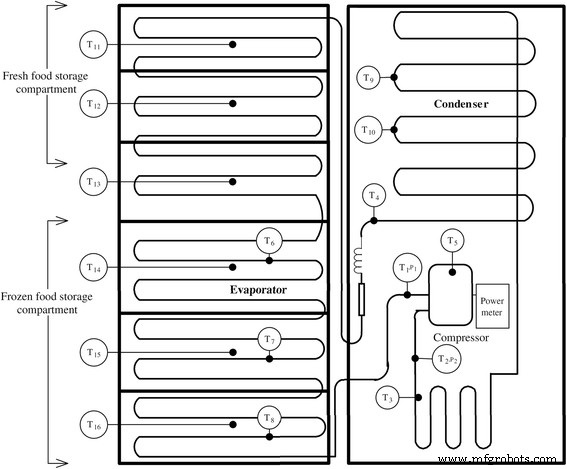
Schematic diagram of a domestic refrigerator with HFC134a, mineral oil and TiO2 nanoparticles [96]. Reproduced with permission from Elsevier
In addition, there is likewise a forward-looking study on the effect on the environment. Javadi and Saidur [103] observed that adding 0.1% of TiO2 nanoparticles to mineral oil-R134a could result in the maximum energy savings of 25% and reduce the CO2 emission by 7 million tons by year of 2030 in Malaysia.
It can be seen from Table 2 that the amounts of nanoparticles used in refrigerants were very low as below 0.1% [94,95,96,97,98,99,100,101,102,103], which can prevent clogging by the possible sedimentation of nanoparticles. However, although all results seemed positive, the long-term performance of the refrigeration system using nano-refrigerants is a great challenge.
Lin et al. [15] investigated the suspending ratio of (0.1 to 1%) nanolubricant–refrigerant after continuous alternation processes of condensation and evaporation. The schematic diagram and photographic view of their experimental system is shown in Fig. 8. They found that the degradation ratio was 28 to 73% after 20 times’ alternate operations. Also, they found lower particle loading can reduce the degradation speed. It can be concluded that the longtime performance of nano-refrigerant system is the essential step for further application in nano-refrigeration system.
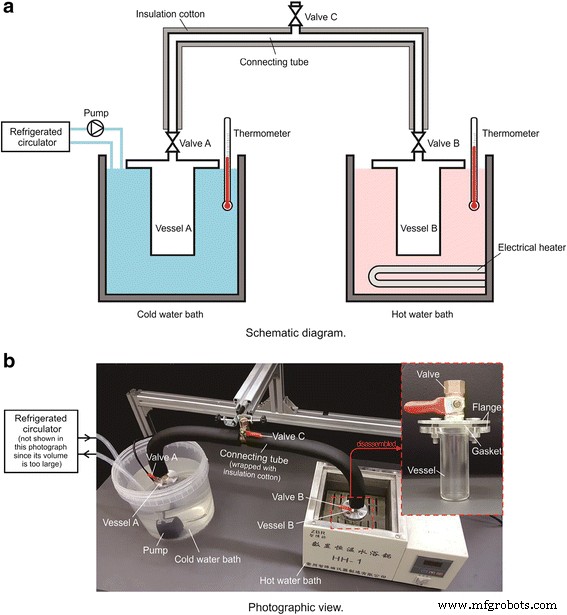
아 , b Experimental setup for condensation–evaporation alternation [15]. Reproduced with permission from Elsevier
The storage of latent heat is through the most efficient mean of storing thermal energy. The conventional PCMs have a shortcoming of inadequate heat transfer performance which can reduce the rate of storing and releasing thermal energy. Therefore, some researchers have studied the method of improving the heat transfer performance by adding nanoparticles into PCMs.
Usages of PCMs mainly include energy storage of heating or cooling capacity. Research on cool storage application of TiO2 nano-PCMs is relatively rare. Liu et al. [104] find that thermal conductivity of saturated BaCl2 aqueous solution increases remarkably when adding a small amount of TiO2 nanoparticles. They found the thermal conductivity was increased by 15.65% as the TiO2 nanoparticle volume fraction was 1.13% at temperature of 15 °C. They thought this nanofluid is a good phase change materials (PCMs) with higher cool storage/supply capacity and rate compared with its base fluids, which exhibited good potential for being applied to cool storage as a substitute for conventional PCMs.
Another similar study was conducted by He et al. [105]. They also found the thermal conductivity of saturated BaCl2 aqueous solution can be distinctly enhanced by 12.76% when adding a small amount of TiO2 nanoparticles at −5 °C. Although decreases in the latent heat and specific heat and an increase in viscosity were found, those varieties have little effect on the cool storage system since the supercooling degree is reduced by 84.92%. They also thought that TiO2 -saturated BaCl2 aqueous solution is suitable for low-temperature energy storage industries.
Studies on cool storage of TiO2 nano-PCMs are in the minority, while most PCM applications focus on the heat storage. Table 3 shows a brief summary on the thermal conductivities and the latent heat of TiO2 nano-PCMs for thermal storage applications in existing literatures. Sharma et al. [106] prepared a composite of palmitic acid (PA) and TiO2 nanoparticles with SDBS as dispersant for thermal energy storage application. The preparation steps of PA–TiO2 composites are shown in Fig. 9. It can be observed that the dispersion methods including adding surfactant, stirring, and ultrasonic vibration were implemented under the condition that the temperature of the base PA is above the melting temperature to confirm its liquid state.
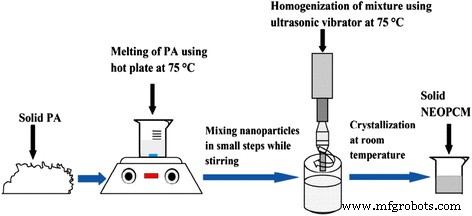
Preparation steps of PA–TiO2 composites [106]. Reproduced with permission from Elsevier
Their results showed that the thermal conductivity increased by 12.7, 20.6, 46.6, and 80% when the mass fractions of TiO2 nanoparticle were 0.5, 1, 3, and 5%, respectively. And they considered this PCM could be a good candidate as potential solar thermal energy storage materials due to its high latent heat and thermal reliability of palmitic acid. Harikrishnan et al. [107] dispersed TiO2 nanoparticles into PCM stearic acid and found this composite can accelerate the melting and solidification rates due to the enhanced heat transfer performance. They also observed that the addition of 0.3% nano-TiO2 nanoparticles can increase the thermal conductivity of stearic acid by approximately 63%. In their another research [108], they used stearic acid and lauric as base PCM and found an increment of 42% in thermal conductivity and a reduction of only 2% of latent heat of fusion. Motahar et al. [109] dispersed the TiO2 nanoparticles into organic PCM n-octadecane and found that the maximum enhancements of thermal conductivity in solid and liquid phases occurred at 3 and 4 wt.%, respectively. Moreover, the maximum average thermal conductivity enhancement for both phases was 26.6% when loading 5 wt.% nanoparticles.
Another experimental research focusing on the solidification process of PCM containing TiO2 nanoparticles was also performed by Motahar et al. [110]. They observed that the rheological behavior of liquid PCM–TiO2 at higher loading tends to Bingham fluids so that their solidification experiments were performed within 0–2.17 Bingham numbers. The results showed that the addition of TiO2 nanoparticles can enhance the thermal conduction process and hence increase the solidified volume. For particle mass loading of 1, 2, and 4%, the solidified volume fraction was increased by 7, 9, and 18%, respectively. At last, they proposed a universal correlation to predict the solidified volume fraction as a function of Fourier number, Rayleigh number, solid Stefan number, Bingham number, and particle loading.
Most of the results showed that when adding TiO2 nanoparticles, the thermal conductivity of PCMs can be greatly increased, while the latent heat will be decreased slightly, which is probably as a result of the thermal conductivity of nanoparticles which is much larger than the base composite, while the nanoparticles will not take part in the phase changing process as the base composite. However, in some case, both of the thermal conductivity and latent heat capacity of PCMs were considered to be elevated. Wang et al. [111] prepared nano-PCMs by adding TiO2 nanoparticles into paraffin. They found the addition of TiO2 nanoparticles can change the phase transition temperature and latent heat capacity of paraffin. The phase transition temperature dropped with <1% loading, while increased with>2% loading of particles. The latent heat increased firstly and then decreased as the loading of particles increase. And the turning concentration is 0.7 wt.%, at which a maximum latent heat capacity can be achieved. While the thermal conductivity of the nano-PCMs increased monotonously with the loading of TiO2 nanoparticles. When the loading of TiO2 nanoparticles reached 7 wt.%, the thermal conductivity was increased by 13% but the latent heat was reduced by 9%.
The characteristics of boiling heat transfer and critical heat flux enhancement of nanofluids can be utilized in the heat pipe to improve its performance and broaden the application range. And some numerical results [112, 113] have shown that for thermosyphon heat pipe, using the nanofluid could achieve a better heat transfer characteristics. Also, some researchers have carried out related research using TiO2 nanofluids.
Zhou et al. [114] tested gravity heat pipes filled with DI water and TiO2 nanofluids, where the concentration and filling ratio of nanoparticles were varied and the initial temperature distribution was given. The result indicated that the heat pipes filled with nanofluids had a lower start-up temperature and a shorter start-up time in evaporation section under the condition of a water bath. And the biggest temperature drop between the evaporation section and the condensation section for heat pipes filled with TiO2 nanofluids was lower than those filled with DI water. The start-up time of heat pipes with filling ratios ranged between 50 and 70% in the evaporation section increased with the increase of the filling ratio and heating temperature, but the small inclination angle had a negative effect on the start-up performance.
Saleh et al. [65] collected data from different nanofluid experiments, where particle volume loading was up to 1.0% and the temperature of measurements ranged from 10 to 60 °C. They discovered that these data agreed with the classical Brownian motion theoretical model. They also investigated experimentally the effect of nanofluids on the thermal performance of heat pipes by measuring the wall temperature and thermal resistance distributions between the evaporation and condensation section. They found that distilled water and nanofluids achieved the best heat transfer performance when the inclination was set to 45° and the charge volume ratio of working fluid was 60%.
In 2015, Monirimanesh et al. [115] designed a thermosyphon-type heat pipe heat exchanger (HPHX) using TiO2 nanofluids as the working fluid to save energy in an air conditioning system. Their experimental apparatus was constructed as shown in Fig. 10. They establish a pre-cooling and pre-heating device to produce altered conditions of the inlet air for investigating the performance of HPHX. The evaporator and condenser section of the HPHX functioned as a pre-cooler and reheating coil for the air conditioning system respectively. They also employed an electric heater and electric boiler to supply heat and steam into the entered fresh air by a fan for the purpose of simulating the hot and humid climate. Their results showed that using TiO2 nanofluids and increasing the HPHX number of rows could make a part of air condensed on the evaporator fin, which could enhance the energy in the pre-cooling section. The use of 3 wt.% TiO2 –methanol nanofluids in a four-row HPHX could achieve the highest energy savings ranging from 30.6 to 32.8% when the inlet air under the properties of 45 °C and 50–74% relative humidity. Based on a comprehensive consideration of the main purpose of supplying the energy required for reheating, they suggested that 2 wt.% TiO2 –methanol nanofluid for the four-row HPHX would have been adequate and more economical.
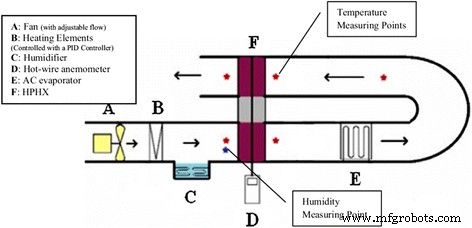
Schematic of the experimental apparatus [115]. Reproduced with permission from Springer
The mass transfer of nanofluids is another important application aspect of TiO2 nanofluids. Current research has shown that TiO2 nanofluids can be used to enhance the absorption process of CO2 and NH3 as well as the mass transfer coefficient of electrolyte fluids.
Li et al. [116] prepared stable N -methyldiethanolamine (MDEA)-based nanofluids to strengthen the absorption performance of CO2 in the MDEA solution. The CO2 absorption characteristics in the gas/liquid interface of nanofluids were investigated by measuring the absolute pressure drop of gas. The mass fraction of MDEA was 50%. And they used two particle mass fractions of 0.1 and 0.4%. The results showed that the CO2 absorption rate increases with increasing temperature and it is enhanced by the added nanoparticles. However, at 20 and 30 °C, the enhancement caused by the mass fraction of nanoparticle (0.1 and 0.4%) reduced gradually. The effective absorption ratio varied from 1.03 to 1.14. Also, CO2 bubble absorption ratio increased with the increase of nanoparticle mass fraction.
Yang [117] prepared stable TiO2 nanofluids without adding dispersant and then carried out a comparative experiment on the falling film performance of absorption of ammonia gas by nanofluids and pure water. The schematic diagram of the experimental system for NH3 –H2 O nanofluid falling film absorption is shown in Fig. 11. They found that the absorption rate of ammonia gas can be increased by 10% when adding anatase TiO2 nanofluids. Wu [118] used the similar experimental device but changed the falling film tube of Fig. 11 into a fin tube. He investigated the effect of rutile TiO2 nanofluids on the ammonia absorption performance of falling film outside a fin tube. The result showed that the combined use of zigzag tubule and TiO2 nanofluids can strengthen the ammonia–water falling film absorption and the maximum increment can reach 60.8%.
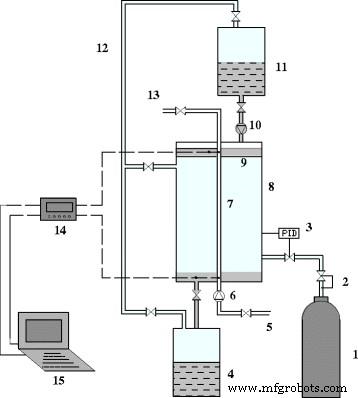
Schematic diagram of the experimental system for NH3 –H2 O nanofluid falling film absorption [117]. 1 NH3 vessel, 2 decompression valve, 3 constant pressure controller, 4 , 11 container of solution, 5 inlet of cooling water, 6 , 10 constant flow controller, 7 falling film tube, 8 visible absorber body, 9 solution distributor, 12 tubes for balancing pressure, 13 outlet of cooling water, 14 HP data acquisition instrument, 15 computer
Beiki et al. [119] investigated experimentally the turbulent mass transfer characteristics of TiO2 and γ-Al2 O3 electrolyte nanofluids in a circular tube. The results showed that adding 0.015 vol.% TiO2 and 0.01 vol.% γ-Al2 O3 could bring an increase in mass transfer coefficient of the electrolyte solution by 18 and 10%, respectively. They found that the enhancement ratio was independent of Reynolds number. The mass transfer coefficients increased firstly and then decreased as the nanoparticle loading increase. They attributed the cause of the existing of optimal particles’ loading to the clustering of nanoparticles and forming bigger agglomerates with smaller Brownian velocity when exceeding the optimum loading.
As a coolant, nanofluids’ heat transfer enhancement characteristic can improve the cooling performance [120]. Moreover, when nanofluids are used for milling, another characteristic of nanofluids viz. enhancement in wear resistance can also play an important role in extending the lifetime of the milling tool.
Yogeswaran et al. [121] investigated experimentally the effects of coolant of TiO2 –EG nanofluid on the tool wear and workpiece temperature at the various milling conditions when used for milling a stainless steel AISI 304. The milling tool was made of a TiN-coated carbide insert. The results showed that comparing to pure base fluid, the workpiece temperature was reduced by 30% when using the nanofluid as coolant. The tool wear from milling using the EG-based TiO2 nano-coolant is much less than using the normal commercial coolant because the nanofluids can reduce the heat penetrating into the inserts. And the tool life is increased as a result of the nanoparticles reduces the damage on the edge of the tool.
Muthusamy et al. [122] also compared the efficiency of nanoparticle-based coolant (TiO2 –EG) and conventional water-soluble coolant on the tool life and wear performance of a TiN-coated carbide insert in the end-milling process of AISI304 stainless steel. The results showed that using TiO2 –EG nanofluid as coolant could increase the tool life from 32.67 to 54.9 min (increased by 40.55%) comparing to that using TiO2 –EG nanofluid as coolant instead of water-soluble coolant. They attributed the cause to a Ti nanoparticle layer on the edge of the insert formed during the milling process when using TiO2 –EG nanofluid, which can be proved from the SEM and EDX of cutting edge as shown in Fig. 12. When using nanofluids as coolant, the oxidation still occurred despite the cutting temperature was reduced at the interface of the tool and workpiece since it can be found from Fig. 12 the O peak on the EDX spectrum. The hard oxidation layer was formed due to the entering of oxygen from TiO2 –EG nanofluid into the tool–workpiece interface. Then, the hard oxidation layer can protect the tool from micro-cracking and chipping wear because it could not be easily detached despite under the severe impact of the milling force and took parts of the tool surface from the workpiece.
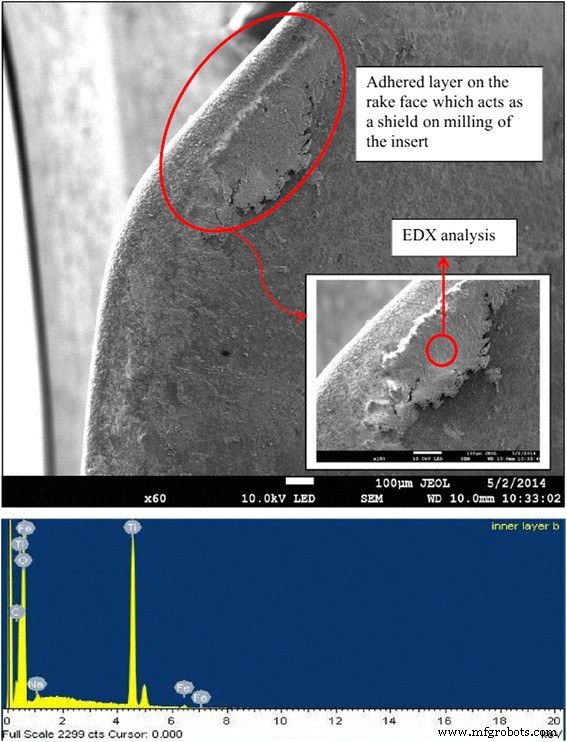
SEM and EDX of cutting edge [122]. At a cutting speed of 1500 rpm, feed rate of 0.02-mm tooth, and axial depth of 0.1 mm using nanoparticle-based coolant at a cutting distance of 180 mm (×60 magnification). Reproduced with permission from Springer
The above energy-related examples have exhibited the extensive application prospect and excellent properties of TiO2 nanofluids. Although in some cases, especially in heat transfer applications, the heat transfer performance of TiO2 nanofluids are not better than that of Ag, Cu, and CNT nanofluids, TiO2 nanofluid is also a good choice due to their comprehensive properties for instance better dispersion and chemical stability, security, and economy.
Although TiO2 nanofluids have showed great enhancement in heat transfer of solar collectors, refrigeration, energy storage, heat pipes, and coolant of milling, the investigations on the performances including dispersion stability and heat transfer performance after running operations are in great lack. Most dispersion stability studies are in static conditions, but it is important that the nanofluids prepared should be treated in the practical application conditions to examine the dynamic cycle stability and the sustainability of both system performance and components of nanofluids.
Generally, the biggest downside in application of nanofluids is the sedimentation and degeneration of nanoparticles after long running which makes the long-term performances of nanofluid system challenged. Some researchers have proposed a new idea and a novel method to re-disperse the aggregates in real time of the running system [123]. However, the concrete effect of the device has to be verified experimentally, and then, the design and location of the re-dispersion device needs to be improved. The surfactant is expected to have positive effect on the re-dispersion characteristic of aggregates. However, one of the biggest flaws in using surfactants is the occurrence of foaming when the fluids are under flowing or heating conditions which would have adverse impacts on the heat or mass transfer application of nanofluids. This defect suggests the amount of surfactant employed in the nanofluids should be limited.
Another great limitation in application of nanofluid is the increase in pumping power and pressure drop of nanofluids, which is essential for the high-quality application of solar collectors, refrigeration, and heat pipes. For instance, Sajadi and Kazemi [124] found the proportional increase in pressure drop of TiO2 nanofluids is higher than that of heat transfer coefficient. While Teng et al. [125] found the pressure drop proportion of TiO2 nanofluids for turbulent flow is lower than that for laminar flow. Therefore, if the extra energy consumption by the increased viscosity of nanofluids exceeds the benefit from the heat or mass transfer enhancement, there will be no application prospect. The most extreme case is when a large amount of agglomerations emerge, the pumping power and pressure drop of nanofluids will be greatly increased, which might lead to serious impact on system performance. Moreover, based on the similarity principle in heat transfer study, for instance in forced convection process, Nusselt number is determined by Reynolds number and Prandtl number, different thermal conductivity and viscosity will induce different Nu even though for the same experimental heat transfer coefficient. Therefore, the properties of nanofluids are essential for quantitative study in those application fields.
As a widely used material in considerable fields, TiO2 has been explored several hundred years, and its nanofluidic form is also firmly worth studying and expected to make greater contributions owing to the outstanding physical and chemical properties. This paper provides a summary of the research outcomes of TiO2 nanofluids up to now, including the preparation and stability of TiO2 as well as three vital properties of TiO2 nanofluids. It can be concluded that TiO2 nanofluids show very comprehensive applications in heat transfer or other energy fields due to their good dispersion stability in both hydrophilic and lipophilic liquids, nontoxic and non-corrosive natures, chemical stability, lower price, and good appearance. Therefore, TiO2 nanofluid is thought as one of the closest kinds to practical industrial application environment because of their better dispersion and chemical stability, security, and economy.
However, although TiO2 nanofluids have shown enormously exciting potential applications, before commercialization of nanofluids, some urgent problems are summarized as follows:
Firstly, acquiring high-quantity nanofluid with outstanding long-term and high-temperature stability is the fundamental of the entire research since in any practical application, it is essential to have a stable suspension.
Secondly, the way to enhance and keep the stability of nanofluids in real time is a key issue in the actual use since the sedimentations of nanoparticles seem inevitable after a long-term running. The method to re-disperse the aggregation of nanoparticles in real time by adding some dispersion device in the system with functions of ultrasound or agitation might be a useful option [123].
Thirdly, although the surfactants were used to improve the dispersion and adhesion performance of nanoparticles in liquid, the effect of surfactants on the physical properties and system performance needs to be investigated. The amount of surfactants should be investigated experimentally owing to the positive and negative effects of surfactants.
Fourth, the pumping power or pressure drop of nanofluids is another challenge for the engineering application. Using nanofluids with higher viscosity than base fluids will induce a higher pressure drop and hence needs more pumping power [125]. The method to achieve higher heat transfer coefficient and lower pressure drop needs to be further studied.
Fifth, the waste management of the invalid nanofluids should also be considered when applying them to industrial systems. The impact on the environment by the nanofluids restricts many kinds of nanofluids containing heavy metal, toxic substance, or other hazardous substances. The super whiteness dyeing behavior of TiO2 nanofluids should also be noticed to prevent the environment getting contaminated.
Sixth, although some studies have analyzed the entropy generation in tubes [126], microchannels [127], sheet, and other types of flow [128, 129], the entropy generation characteristic of nanofluid in the full system is actually the most important parameter for the full-system application or designing.
Last but not least, there is lack of evaluation index on the performance of nanofluids, especially on the stability, adhesion, and property sustainability of nanofluids. There is no unified indicator to evaluate the stability and adhesion of nanofluids. The uniform evaluation indexes on the different properties of nanofluids are needed [130].
The above problems are urgently needed to solve for the further application of TiO2 nanofluids, which point out the directions of the future works in this field. It is believed that these problems and challenges will be solved or reduced with the development of nanofluid technology in the future.
This second part of the review summarizes recent research on application of TiO2 nanofluids and identifies the challenges and opportunities for the further exploration of TiO2 nanofluids. It can be concluded that although particle loading has exhibited a positive correlation with thermal conductivity of nanofluids, the effects of other factors including particle shape, size, base fluid type, temperature, surfactant, and sonication are unified. Even for particle loading effect, the intensities of growth in thermal conductivity differ widely for different samples. TiO2 nanofluids have shown good applications in many energy-related filed. However, the indeterminacy of long-term performances for both nanofluid and system and the increment in pressure drop are needed to investigate for further application. The forecast research hotspots are regarded as the long-term and high-temperature stability and re-disperse the aggregation of nanoparticles in real-time system, the required amount of surfactants, the heat transfer and pumping power characteristics, and the evaluation index on the stability, adhesion, and property sustainability of nanofluids.
나노물질
세계에서 가장 널리 사용되는 재료의 제품 수명 주기 콘크리트는 주간 고속도로에서 우뚝 솟은 도시 고층 빌딩에 이르기까지 도시 기반 시설의 고정물입니다. 콘크리트는 세계에서 가장 일반적으로 사용되는 인공 재료이기 때문에 어디에서나 쉽게 발견할 수 있습니다. 미국에서만 연간 약 100억 톤의 콘크리트가 생산됩니다. 콘크리트는 양생 단계에 따라 가단성 또는 견고한 특성을 지닌 매우 다양한 건축 자재입니다. 그것은 액체 시멘트와 혼합 된 골재와 암석으로 구성됩니다. 일정 시간이 지나면 콘크리트는 수화라고 알려진 화학 반응으로 인해 암석
지능이란 무엇입니까? 우선 지능의 의미를 이해하자. 지능에는 많은 의미가 있지만 우리는 시스템에서 발견되는 일련의 과정, 즉 이해하고 배우고 삶의 새로운 상황에 적응하는 과정이라고 가정할 수 있습니다. 인공 지능(AI)이란 무엇입니까? 인공지능(AI)은 기계, 특히 컴퓨터 시스템에 의해 적응된 인간 지능의 시뮬레이션입니다. 이러한 프로세스에는 정보 학습 및 이해(정보 및 정보 사용 규칙 획득), 자가 수정이 포함됩니다. AI의 응용 프로그램에는 전문가 시스템, 음성 인식 및 머신 비전이 포함됩니다. 인공 지능(AI)의 역사